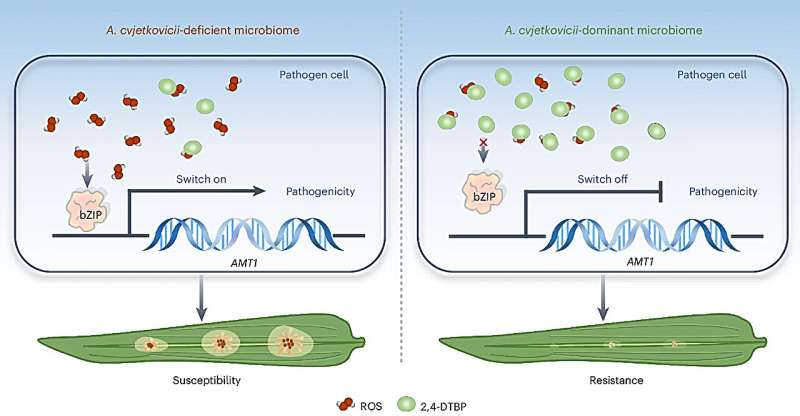This article has been reviewed according to Science X's editorial process and policies. Editors have highlighted the following attributes while ensuring the content's credibility:
fact-checked
peer-reviewed publication
trusted source
proofread
How friendly fungi is helping rice thrive

Researchers from The University of Western Australia, in collaboration with Chinese scientists, have uncovered a fascinating aspect of plant-microbe interactions, revealing how a specific leaf fungus enhances rice disease resistance through chemical signaling.
Published in Nature Microbiology, the research offers new insights into the complex relationships between rice, its resident microbiota and invasive pathogens.
Rice is a staple food for more than half of the world's population, providing a major source of calories and nutrition and a vital agricultural commodity, supporting the livelihoods of millions of farmers, particularly in Asia, where 90% of the world's rice is produced and consumed.
Study co-author Xiaoyu Liu from the ARC Center for Plant Energy Biology at UWA's School of Molecular Sciences, said the research offered a significant leap towards understanding plant defense mechanisms, and in particular rice.
"We already knew that microbes, known as phyllosphere microbiota, that live on the above-ground parts of plants, established symbiotic relationships with their host plants through nutrient exchange and signal communication," Liu said.
"These microorganisms significantly influence plants' different characteristics and fitness, and play an essential role in pathogen defense systems, however, the mechanisms by which they did this have remained largely unknown, until now."
Lead author Professor Mengcen Wang said after extensive greenhouse and field experiments, the team discovered the distinct differences in disease resistance among various rice varieties vanished when the phyllosphere microbial community was disrupted.
"Guided by this interesting phenomenon, we found besides disease resistance genes, phyllosphere microbiota also played an important role in regulating rice disease resistance," Professor Wang said.
Researchers selected three rice varieties—Teqing, Nipponbare, and Lemont—for further investigation and through microbiome analysis and high-throughput screening, identified a phyllosphere fungus, Aspergillus cvjetkovicii, which was a key player in enhancing rice disease resistance.
"We found that a metabolite known as 2,4-DTBP, produced by the fungus, boosted rice's disease resistance by neutralizing harmful molecules that build up during the growth of harmful fungi and prevented the fungi from causing infections," Liu said.
"Our experiments showed that both the fungus and the metabolite were effective in protecting rice from diseases."
The findings offered new ways to develop stable and efficient methods for controlling plant diseases, the researchers said.
More information: Xiaoyan Fan et al, Aspergillus cvjetkovicii protects against phytopathogens through interspecies chemical signalling in the phyllosphere, Nature Microbiology (2024). DOI: 10.1038/s41564-024-01781-z
Journal information: Nature Microbiology
Provided by University of Western Australia




















